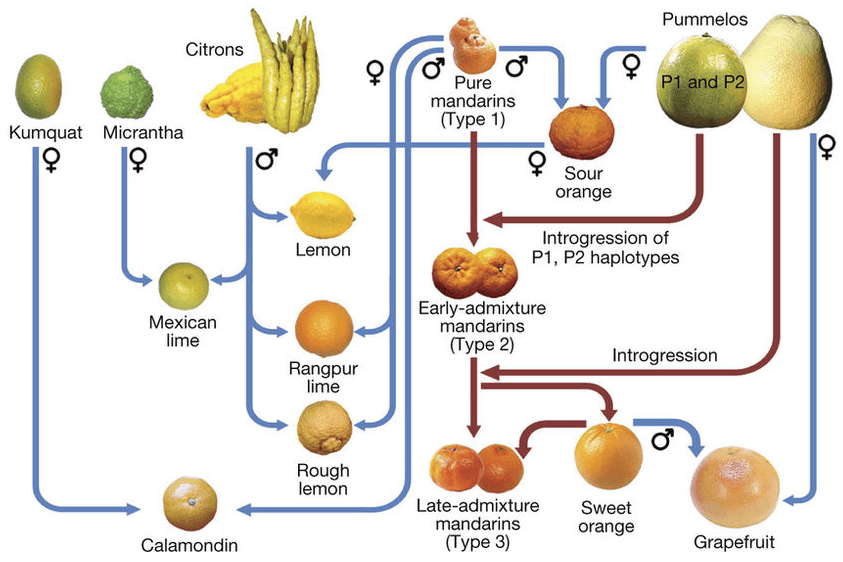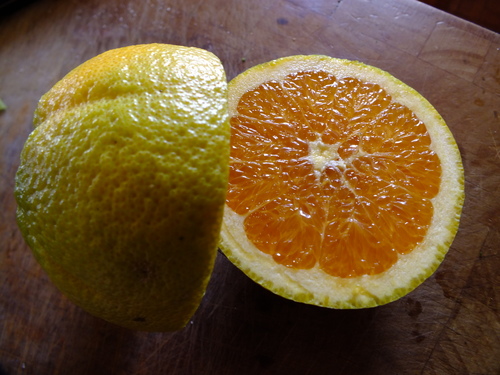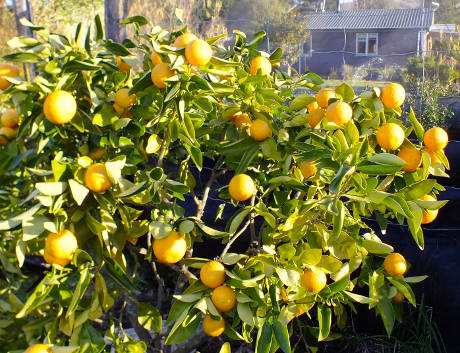Citrus
Planting and Care
- Warm sheltered sunny position
- Organically fertile good draining but moisture retentive soils
- Much generously after planting and every season to keep the roots cool, moist and undisturbed
- Plenty of consistent deep watering's over the hot dry months of the year
- Light but consistent feedings from early spring to early autumn (3-4 times over the growing season). DON’T dump a whole lot of fertiliser around it in spring then forget it for the rest of the year!
All Citrus varieties thrive in a warm sheltered sunny spot, in organically rich, moisture retentive but good draining soils. Their preference is towards a slightly acidic soil. Citrus trees have very fine surface roots so it is important to keep the roots well mulched and not to disturb or underplant around them.
Citrus do not like spots exposed to constant strong cold winds, shade, heavy wet poor draining soils, strong coastal conditions. However, they are quite hardy and will stand mild winter frosts without being affected – as long as the roots are not continually sitting in wet cold soils.
Enrich the soil with good quality Compost, Blood and Bone & Pumice. Mulch well with Compost after planting to keep its fine surface roots cool, moist & undisturbed (don’t cultivate or plant around it). Provide plenty of consistent watering's over the growing season. They are heavy feeders so regular consistent light feedings with a balanced Citrus Tree fertiliser and Blood & Bone in spring, early summer and once more in early autumn are essential for good fruit production. If growing organically, the Citrus Tree fertiliser can be replaced with organic fertilizers (compost, blood and bone, chicken manure, sheep manure, seaweed, etc). Apply an annual dressing of Gypsum.
Citrus fruit is very high in natural vitamins, minerals and fibre. The best place to store citrus fruit is to leave them on the tree until you need them. Once picked, citrus fruit do not continue to ripen. Always use a good sharp pair of secateurs to cut the fruit off the tree. Don’t pull them off, as it can damage the tree branches and often strips off the fruit cap causing the fruit to go off quickly. Cut the stem holding the fruit off about 15-20mm back from the fruit. That way you are giving the tree a light prune and promoting fresh bushy growth.
Citrus trees grow readily in large tubs (a large tub is something that can hold 40-50litres of potting mix) and look fantastic in courtyards, patios, decks, entrances. Keep in mind you will need to water and feed them a bit more than if planted in the garden. Tubs can dry out in just 1 day over the hot summer months. Also you will need to keep the nutrient levels up a bit more as they are depleted quicker by the trees roots in the tub (increase the light feedings by 2 more applications). Over the colder months of the year don’t water late in the afternoon, preferably water earlier in the day.
Citrus can be prone to magnesium deficiency (yellowing leaves with green veins). A dose of Epsom salts, sprinkled or watered on, is what’s needed in this case. The ideal PH soil level for citrus is 6.8PH. You can easily check your soil PH with a simple PH soil test kit. Citrus like their soil PH to be at this level.
Pruning
A light annual all round trim in early spring will promote fresh bushy spring growth and keep the plant to around 2.5m tall. This will enable easy fruit picking, good fruit harvests and easy tree management. Depending on growth over summer, another light trim in late summer/early autumn to cut back any lanky or untidy growth is good. It’s best to prune citrus in spring/autumn only, as pruning over the summer months attracts the citrus borer beetle (would you believe, a NZ native insect) to the fresh cuts. Keep an eye out for any growth that appears below the graft – knock these off as you don’t want the wild trifoliata rootstock to take over.
Pollination
All citrus varieties are self fertile so can be planted alone and fruit will be produced. Take care when planting seedless varieties (like Mandarin ‘Miho’) with other citrus trees, as despite the variety being seedless, they can form seeds if cross pollinated with another variety flowering at the same time.
Propagation
Growing citrus from seed
Citrus can be grown from seed, if you can find seed in the fruit you wish to propagate. Best sown fresh.
Reasonably slow to grow
Grafting and budding citrus trees
Budding is typically done in January for citrus in NZ
Rootstock
Trifoliata – This rootstock is grown from seed sourced from Australia or USA. The seeds are harvested from a particular type of sour orange which produces many seeds inside the fruit. Trifoliata is the standard rootstock for citrus trees with excellent hardiness to difficult soil conditions, to cold soil temperatures, with good vigour and heavy crops. Rootstock growth (‘suckers’) that sprouts from below the bud union (about 15cm from ground level) will look different to the variety growth with distinctive small tri-lobed leaves and many sharp spikes – this growth should be cleanly snipped off.
Citrus trees grafted on to Trifoliata citrus rootstock have better tolerance to heavier soil types we have in NZ and has been proven worldwide to be the leading citrus rootstock for grafting (superior growth habit, fruit performance). It would be the preferred rootstock for the cooler regions of NZ. Untrimmed, a trifoliata grafted citrus tree will grow naturally to 2.5 -3m tall, but responds to pruning for height control easily. Prune for height control in spring, early summer or autumn. Don't prune in summer as it will attract the native citrus borer to your tree.
Flying Dragon – A dwarfing rootstock for citrus trees. Trees on Flying Dragon are best planted in warmer areas of the garden as the rootstock is not very cold tolerant. Another benefit of this rootstock is that the fruit is produced at an earlier age compared to trees on Trifoliata rootstock.Rootstock growth (‘suckers’) that sprouts from below the bud union (about 15cm from ground level) will look different to the variety growth with distinctive small tri-lobed leaves and many sharp spikes – this growth should be cleanly snipped off. This rootstock is grown from seed sourced from Australia or USA. The seeds are harvested from a particular variety of sour orange which produces many seeds inside the fruit.
Citrus trees grafted on to dwarf Flying Dragon rootstock are ideal for smaller suburban gardens and growing in large tubs. They form a compact citrus tree growing to aprox 1.5m tall x 1.5m wide. They are less tolerant of the colder regions of NZ, but will still grow fine if given a warm sunny sheltered position in organically enriched good draining soil.




